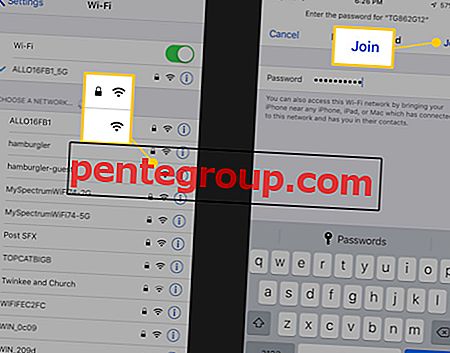L'errore iTunes 17 si verifica principalmente a causa del problema di connettività; soprattutto quando il tuo computer non è in grado di connettersi ai server Apple o al tuo iPhone. È molto simile all'errore 3194 di iTunes e quindi richiede la risoluzione delle stesse soluzioni.
L'errore 17 potrebbe anche apparire a causa della versione obsoleta di iTunes e di un software di sicurezza troppo sensibile. Se hai riscontrato questo problema durante l'aggiornamento del tuo dispositivo iOS e stai cercando modi rapidi per risolverlo, prova queste soluzioni praticabili.

Come risolvere l'errore di iTunes 17
Consigli veloci:
- Scollega il dispositivo iOS dal computer → riavvia il dispositivo → ricollegalo al computer e prova ad aggiornare di nuovo.
- Se ne hai un altro disponibile, prova a usarlo per connettere il tuo dispositivo al computer.
Controlla la tua rete
Dal momento che stiamo parlando di problemi di connettività, il più delle volte il problema è che iTunes tenta di connettersi e scaricare il file IPSW richiesto dal server Apple senza successo. Questo non significa necessariamente che la tua rete sia inattiva o difettosa, ma controllarla aiuta.
Se sei su Wi-Fi, assicurati che sia stabile. Se puoi passare alla LAN fino a quando iTunes non scarica il file, fallo per una rete stabile. Ma se sei sicuro che la tua rete funzioni correttamente, passa al suggerimento successivo.
Rimuovere temporaneamente il software di sicurezza
Se hai installato un software di sicurezza sul tuo computer, testalo per scoprire se sta impedendo a iTunes di fare la sua solita attività. Potrebbe interferire con la connessione del tuo computer a iTunes.
Quindi, prova a rimuovere temporaneamente il tuo software di sicurezza. Alcune app di sicurezza potrebbero non essere completamente disinstallate. Pertanto, dovrai rimuovere ed eseguire un'utilità di pulizia per rimuoverla. Se hai bisogno di ulteriore aiuto, contatta il tuo software di sicurezza, fornitore.
Ripristina file host
Il file Hosts viene sostanzialmente utilizzato dal sistema operativo per mappare i nomi host su indirizzi IP. Prova a ripristinarlo.
Ripristina il file Hosts su Windows
Passo 1. Prima di tutto, apri il Blocco note.
Passo 2. Ora devi copiare il seguente testo. Quindi, incollalo nel file.
# Copyright (c) 1993-2006 Microsoft Corp. # # This is a sample HOSTS file used by Microsoft TCP/IP for Windows. # # This file contains the mappings of IP addresses to host names. Each # entry should be kept on an individual line. The IP address should # be placed in the first column followed by the corresponding host name. # The IP address and the host name should be separated by at least one # space. # # Additionally, comments (such as these) may be inserted on individual # lines or following the machine name denoted by a '#' symbol. # # For example: # # 102.54.94.97 rhino.acme.com # source server # 38.25.63.10 x.acme.com # x client host # localhost name resolution is handle within DNS itself. # 127.0.0.1 localhost # ::1 localhost
# Copyright (c) 1993-2006 Microsoft Corp. # # This is a sample HOSTS file used by Microsoft TCP/IP for Windows. # # This file contains the mappings of IP addresses to host names. Each # entry should be kept on an individual line. The IP address should # be placed in the first column followed by the corresponding host name. # The IP address and the host name should be separated by at least one # space. # # Additionally, comments (such as these) may be inserted on individual # lines or following the machine name denoted by a '#' symbol. # # For example: # # 102.54.94.97 rhino.acme.com # source server # 38.25.63.10 x.acme.com # x client host # localhost name resolution is handle within DNS itself. # 127.0.0.1 localhost # ::1 localhost
# Copyright (c) 1993-2006 Microsoft Corp. # # This is a sample HOSTS file used by Microsoft TCP/IP for Windows. # # This file contains the mappings of IP addresses to host names. Each # entry should be kept on an individual line. The IP address should # be placed in the first column followed by the corresponding host name. # The IP address and the host name should be separated by at least one # space. # # Additionally, comments (such as these) may be inserted on individual # lines or following the machine name denoted by a '#' symbol. # # For example: # # 102.54.94.97 rhino.acme.com # source server # 38.25.63.10 x.acme.com # x client host # localhost name resolution is handle within DNS itself. # 127.0.0.1 localhost # ::1 localhost
# Copyright (c) 1993-2006 Microsoft Corp. # # This is a sample HOSTS file used by Microsoft TCP/IP for Windows. # # This file contains the mappings of IP addresses to host names. Each # entry should be kept on an individual line. The IP address should # be placed in the first column followed by the corresponding host name. # The IP address and the host name should be separated by at least one # space. # # Additionally, comments (such as these) may be inserted on individual # lines or following the machine name denoted by a '#' symbol. # # For example: # # 102.54.94.97 rhino.acme.com # source server # 38.25.63.10 x.acme.com # x client host # localhost name resolution is handle within DNS itself. # 127.0.0.1 localhost # ::1 localhost
# Copyright (c) 1993-2006 Microsoft Corp. # # This is a sample HOSTS file used by Microsoft TCP/IP for Windows. # # This file contains the mappings of IP addresses to host names. Each # entry should be kept on an individual line. The IP address should # be placed in the first column followed by the corresponding host name. # The IP address and the host name should be separated by at least one # space. # # Additionally, comments (such as these) may be inserted on individual # lines or following the machine name denoted by a '#' symbol. # # For example: # # 102.54.94.97 rhino.acme.com # source server # 38.25.63.10 x.acme.com # x client host # localhost name resolution is handle within DNS itself. # 127.0.0.1 localhost # ::1 localhost
# Copyright (c) 1993-2006 Microsoft Corp. # # This is a sample HOSTS file used by Microsoft TCP/IP for Windows. # # This file contains the mappings of IP addresses to host names. Each # entry should be kept on an individual line. The IP address should # be placed in the first column followed by the corresponding host name. # The IP address and the host name should be separated by at least one # space. # # Additionally, comments (such as these) may be inserted on individual # lines or following the machine name denoted by a '#' symbol. # # For example: # # 102.54.94.97 rhino.acme.com # source server # 38.25.63.10 x.acme.com # x client host # localhost name resolution is handle within DNS itself. # 127.0.0.1 localhost # ::1 localhost
# Copyright (c) 1993-2006 Microsoft Corp. # # This is a sample HOSTS file used by Microsoft TCP/IP for Windows. # # This file contains the mappings of IP addresses to host names. Each # entry should be kept on an individual line. The IP address should # be placed in the first column followed by the corresponding host name. # The IP address and the host name should be separated by at least one # space. # # Additionally, comments (such as these) may be inserted on individual # lines or following the machine name denoted by a '#' symbol. # # For example: # # 102.54.94.97 rhino.acme.com # source server # 38.25.63.10 x.acme.com # x client host # localhost name resolution is handle within DNS itself. # 127.0.0.1 localhost # ::1 localhost
# Copyright (c) 1993-2006 Microsoft Corp. # # This is a sample HOSTS file used by Microsoft TCP/IP for Windows. # # This file contains the mappings of IP addresses to host names. Each # entry should be kept on an individual line. The IP address should # be placed in the first column followed by the corresponding host name. # The IP address and the host name should be separated by at least one # space. # # Additionally, comments (such as these) may be inserted on individual # lines or following the machine name denoted by a '#' symbol. # # For example: # # 102.54.94.97 rhino.acme.com # source server # 38.25.63.10 x.acme.com # x client host # localhost name resolution is handle within DNS itself. # 127.0.0.1 localhost # ::1 localhost
# Copyright (c) 1993-2006 Microsoft Corp. # # This is a sample HOSTS file used by Microsoft TCP/IP for Windows. # # This file contains the mappings of IP addresses to host names. Each # entry should be kept on an individual line. The IP address should # be placed in the first column followed by the corresponding host name. # The IP address and the host name should be separated by at least one # space. # # Additionally, comments (such as these) may be inserted on individual # lines or following the machine name denoted by a '#' symbol. # # For example: # # 102.54.94.97 rhino.acme.com # source server # 38.25.63.10 x.acme.com # x client host # localhost name resolution is handle within DNS itself. # 127.0.0.1 localhost # ::1 localhost
# Copyright (c) 1993-2006 Microsoft Corp. # # This is a sample HOSTS file used by Microsoft TCP/IP for Windows. # # This file contains the mappings of IP addresses to host names. Each # entry should be kept on an individual line. The IP address should # be placed in the first column followed by the corresponding host name. # The IP address and the host name should be separated by at least one # space. # # Additionally, comments (such as these) may be inserted on individual # lines or following the machine name denoted by a '#' symbol. # # For example: # # 102.54.94.97 rhino.acme.com # source server # 38.25.63.10 x.acme.com # x client host # localhost name resolution is handle within DNS itself. # 127.0.0.1 localhost # ::1 localhost
# Copyright (c) 1993-2006 Microsoft Corp. # # This is a sample HOSTS file used by Microsoft TCP/IP for Windows. # # This file contains the mappings of IP addresses to host names. Each # entry should be kept on an individual line. The IP address should # be placed in the first column followed by the corresponding host name. # The IP address and the host name should be separated by at least one # space. # # Additionally, comments (such as these) may be inserted on individual # lines or following the machine name denoted by a '#' symbol. # # For example: # # 102.54.94.97 rhino.acme.com # source server # 38.25.63.10 x.acme.com # x client host # localhost name resolution is handle within DNS itself. # 127.0.0.1 localhost # ::1 localhost
# Copyright (c) 1993-2006 Microsoft Corp. # # This is a sample HOSTS file used by Microsoft TCP/IP for Windows. # # This file contains the mappings of IP addresses to host names. Each # entry should be kept on an individual line. The IP address should # be placed in the first column followed by the corresponding host name. # The IP address and the host name should be separated by at least one # space. # # Additionally, comments (such as these) may be inserted on individual # lines or following the machine name denoted by a '#' symbol. # # For example: # # 102.54.94.97 rhino.acme.com # source server # 38.25.63.10 x.acme.com # x client host # localhost name resolution is handle within DNS itself. # 127.0.0.1 localhost # ::1 localhost
# Copyright (c) 1993-2006 Microsoft Corp. # # This is a sample HOSTS file used by Microsoft TCP/IP for Windows. # # This file contains the mappings of IP addresses to host names. Each # entry should be kept on an individual line. The IP address should # be placed in the first column followed by the corresponding host name. # The IP address and the host name should be separated by at least one # space. # # Additionally, comments (such as these) may be inserted on individual # lines or following the machine name denoted by a '#' symbol. # # For example: # # 102.54.94.97 rhino.acme.com # source server # 38.25.63.10 x.acme.com # x client host # localhost name resolution is handle within DNS itself. # 127.0.0.1 localhost # ::1 localhost
# Copyright (c) 1993-2006 Microsoft Corp. # # This is a sample HOSTS file used by Microsoft TCP/IP for Windows. # # This file contains the mappings of IP addresses to host names. Each # entry should be kept on an individual line. The IP address should # be placed in the first column followed by the corresponding host name. # The IP address and the host name should be separated by at least one # space. # # Additionally, comments (such as these) may be inserted on individual # lines or following the machine name denoted by a '#' symbol. # # For example: # # 102.54.94.97 rhino.acme.com # source server # 38.25.63.10 x.acme.com # x client host # localhost name resolution is handle within DNS itself. # 127.0.0.1 localhost # ::1 localhost
# Copyright (c) 1993-2006 Microsoft Corp. # # This is a sample HOSTS file used by Microsoft TCP/IP for Windows. # # This file contains the mappings of IP addresses to host names. Each # entry should be kept on an individual line. The IP address should # be placed in the first column followed by the corresponding host name. # The IP address and the host name should be separated by at least one # space. # # Additionally, comments (such as these) may be inserted on individual # lines or following the machine name denoted by a '#' symbol. # # For example: # # 102.54.94.97 rhino.acme.com # source server # 38.25.63.10 x.acme.com # x client host # localhost name resolution is handle within DNS itself. # 127.0.0.1 localhost # ::1 localhost
# Copyright (c) 1993-2006 Microsoft Corp. # # This is a sample HOSTS file used by Microsoft TCP/IP for Windows. # # This file contains the mappings of IP addresses to host names. Each # entry should be kept on an individual line. The IP address should # be placed in the first column followed by the corresponding host name. # The IP address and the host name should be separated by at least one # space. # # Additionally, comments (such as these) may be inserted on individual # lines or following the machine name denoted by a '#' symbol. # # For example: # # 102.54.94.97 rhino.acme.com # source server # 38.25.63.10 x.acme.com # x client host # localhost name resolution is handle within DNS itself. # 127.0.0.1 localhost # ::1 localhost
# Copyright (c) 1993-2006 Microsoft Corp. # # This is a sample HOSTS file used by Microsoft TCP/IP for Windows. # # This file contains the mappings of IP addresses to host names. Each # entry should be kept on an individual line. The IP address should # be placed in the first column followed by the corresponding host name. # The IP address and the host name should be separated by at least one # space. # # Additionally, comments (such as these) may be inserted on individual # lines or following the machine name denoted by a '#' symbol. # # For example: # # 102.54.94.97 rhino.acme.com # source server # 38.25.63.10 x.acme.com # x client host # localhost name resolution is handle within DNS itself. # 127.0.0.1 localhost # ::1 localhost
# Copyright (c) 1993-2006 Microsoft Corp. # # This is a sample HOSTS file used by Microsoft TCP/IP for Windows. # # This file contains the mappings of IP addresses to host names. Each # entry should be kept on an individual line. The IP address should # be placed in the first column followed by the corresponding host name. # The IP address and the host name should be separated by at least one # space. # # Additionally, comments (such as these) may be inserted on individual # lines or following the machine name denoted by a '#' symbol. # # For example: # # 102.54.94.97 rhino.acme.com # source server # 38.25.63.10 x.acme.com # x client host # localhost name resolution is handle within DNS itself. # 127.0.0.1 localhost # ::1 localhost
# Copyright (c) 1993-2006 Microsoft Corp. # # This is a sample HOSTS file used by Microsoft TCP/IP for Windows. # # This file contains the mappings of IP addresses to host names. Each # entry should be kept on an individual line. The IP address should # be placed in the first column followed by the corresponding host name. # The IP address and the host name should be separated by at least one # space. # # Additionally, comments (such as these) may be inserted on individual # lines or following the machine name denoted by a '#' symbol. # # For example: # # 102.54.94.97 rhino.acme.com # source server # 38.25.63.10 x.acme.com # x client host # localhost name resolution is handle within DNS itself. # 127.0.0.1 localhost # ::1 localhost
# Copyright (c) 1993-2006 Microsoft Corp. # # This is a sample HOSTS file used by Microsoft TCP/IP for Windows. # # This file contains the mappings of IP addresses to host names. Each # entry should be kept on an individual line. The IP address should # be placed in the first column followed by the corresponding host name. # The IP address and the host name should be separated by at least one # space. # # Additionally, comments (such as these) may be inserted on individual # lines or following the machine name denoted by a '#' symbol. # # For example: # # 102.54.94.97 rhino.acme.com # source server # 38.25.63.10 x.acme.com # x client host # localhost name resolution is handle within DNS itself. # 127.0.0.1 localhost # ::1 localhost
Passaggio n. 3. Nel menu File, è necessario selezionare Salva con nome → digitare "hosts" nella casella Nome file . Quindi, salva il file sul desktop.
Passaggio 4. Ora chiudi Blocco note e quindi apri la cartella %WinDir%\System32\Drivers\Etc Per farlo, scorri rapidamente dal bordo destro dello schermo e tocca Cerca → inserisci corsa → fai clic sull'icona Esegui .
In alternativa, è possibile puntare all'angolo in alto a destra dello schermo → spostare il puntatore del mouse verso il basso, quindi selezionare Cerca → digitare Esegui → Esegui icona.
Passaggio n. 5. Successivamente, è necessario digitare %WinDir%\System32\Drivers\Etc nella casella Apri → selezionare OK .
Passaggio n. 6. Ora, scegli il file Hosts, seleziona Rinomina → rinomina il file come "Hosts.old".
Passaggio 7. Successivamente, è necessario copiare o spostare il file Hosts appena creato nel passaggio 3 nella cartella %WinDir%\System32\Drivers\Etc Se ti viene chiesto di inserire una password amministratore, tocca o fai clic su Continua .
Ripristina file host sul tuo Mac
Passo 1. Apri il Finder e seleziona Applicazioni → Utilità.
Passo 2. Quindi, aprire Terminal.
Passaggio n. 3. Ora devi digitare questo comando e premere Invio:
sudo nano /private/etc/hosts
Passaggio 4. Successivamente, è necessario inserire la password con cui si utilizza il segno nel Mac e premere Invio.
Passaggio n. 5. Successivamente, il terminale mostrerà il file hosts.
Aggiorna iTunes
La versione obsoleta di iTunes potrebbe avere un ruolo malvagio. È meglio aggiornarlo all'ultima versione.
Aggiorna iTunes su Mac
Passo 1. Apri iTunes.
Passo 2. Successivamente, seleziona iTunes nella barra dei menu nella parte superiore dello schermo del computer.
Passaggio n. 3. Ora seleziona iTunes → Verifica aggiornamenti.
Successivamente, vai avanti con le istruzioni per installare l'ultima versione.
Aggiorna iTunes su Windows
Passo 1. Apri iTunes e fai clic su Aiuto nella barra dei menu.
Passo 2. Fai clic su Controlla aggiornamenti.
Quindi, seguire le istruzioni per installare la versione più recente.
Prendi l'aiuto dello strumento di terze parti
Nel caso in cui le soluzioni sopra menzionate non abbiano funzionato nel risolvere il problema, utilizzare TunesCare, un pratico software disponibile gratuitamente.
Inoltre, può aiutarti a risolvere molti altri errori di iTunes durante il ripristino o l'aggiornamento del dispositivo iOS.
Passo 1. Innanzitutto, scarica TunesCare sul tuo computer.
- //download.tenorshare.com/downloads/tunescare-trial.exe
- //download.tenorshare.com/downloads/tunescare-mac.dmg
Quindi, fai clic su "Risolvi tutti i problemi di iTunes".
Passo 2. Ora, fai clic su "Ripara iTunes" per scaricare le unità iTunes per la riparazione.
Passaggio n. 3. Una volta scaricato, TunesCare riparerà il tuo iTunes.
Non saranno necessari più di 2 minuti per completare il processo di riparazione.
Hai la meglio dell'errore?
Avendo riscontrato tali problemi in diverse occasioni, posso affermare con certezza che queste soluzioni possono aiutarti a sbarazzarti del problema. La vecchia versione di iTunes e il software di sicurezza sono i due principali colpevoli del problema. Quindi, può essere risolto principalmente aggiornando il primo e disabilitando temporaneamente il secondo.
Potresti voler dare un'occhiata a questi post correlati:
- WinX MediaTrans-il gestore multimediale iPhone più versatile per Windows
- Computer / iTunes non riconosce iPhone? Suggerimenti per risolverlo
- Come risolvere l'errore 9006 di iTunes durante l'aggiornamento / il ripristino di iPhone o iPad
- Come correggere gli errori iTunes 1002/1004/1013/1014/1015
Per leggere ulteriori utili guide per la risoluzione dei problemi, scarica la nostra app e rimani connesso con noi su Facebook, Twitter e Google Plus.












